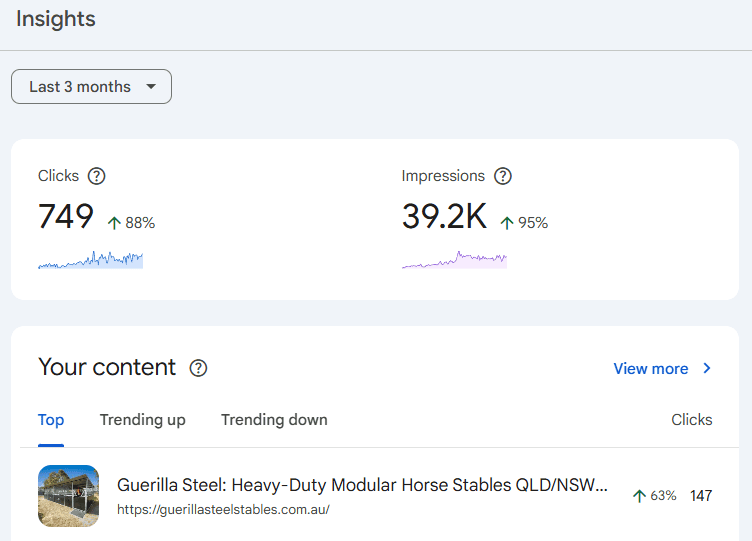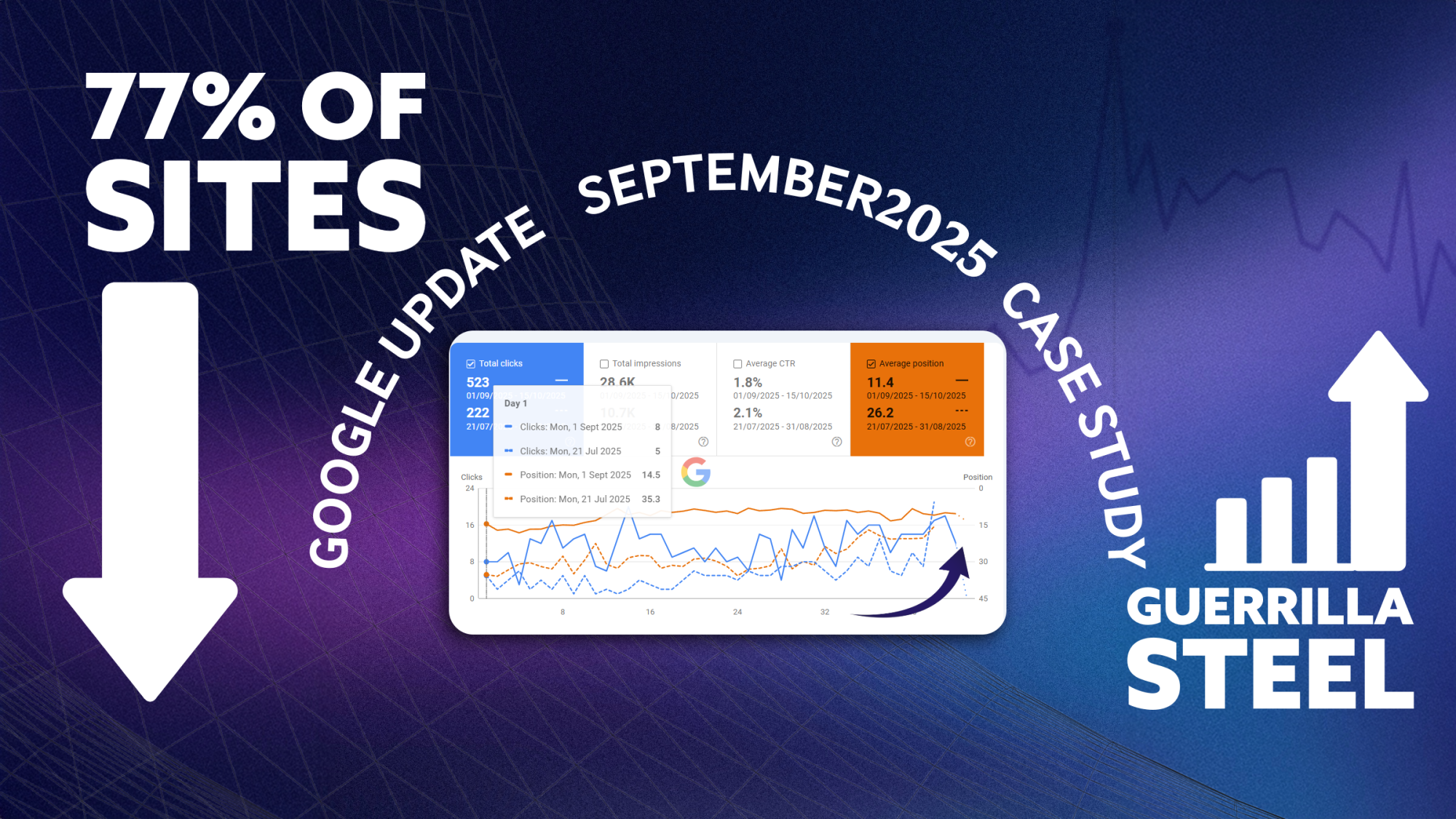When the SEO World Panicked, Strategic Infrastructure Won
September 2025 will go down in SEO history as the month Google broke the internet, or at least, broke a lot of tracking tools.
The removal of the num=100 parameter sent shockwaves through the industry. Google Search Console showed dramatic drops across the board. Third party tools went haywire. And the data was brutal: 77% of sites lost keyword visibility after the change.
SEO Twitter erupted. Panic spreadsheets circulated. Emergency client calls were scheduled.
But here’s what’s interesting: while most of the industry was firefighting, one of our clients, Guerrilla Steel, a steel fabrication business in Ballarat, didn’t just survive the chaos. They improved. Significantly.
This is the 30 day follow up to our August case study where we showed how we got Guerrilla Steel into Google’s AI Overviews in 28 days without an ecommerce platform. Now we’re answering the question everyone’s asking: what happened when Google’s September update hit?
The Numbers: What Actually Happened
Let’s start with the data, because that’s what matters.

90 Day View (Mid July to Mid October):
- 39,200 impressions
- 749 clicks
- 1.9% CTR
- 15.9 average position
Most Recent 30 Days (Mid September to Mid October):
- 18,900 impressions
- 389 clicks
- 2.1% CTR ↑
- 9.6 average position ↑

Now, before you look at those impression numbers and think the 90 day total is higher, look closer at what actually happened.
While 77% of sites were losing visibility, Guerrilla Steel was climbing toward the top 10.
The site launched in February 2025. From July through late August, we saw steady, gradual growth from foundational SEO work: on site optimization, schema implementation, social consistency, and local citations. Daily impressions hovered around 100 300. Solid progress, but nothing explosive.
Then September 1st hit.
The day Google’s update rolled out, Guerrilla Steel spiked to 1,049 impressions in a single day. That’s not a fluctuation, that’s Google’s algorithm recognizing the infrastructure we’d built and saying “okay, this site deserves visibility.”
The 30 day view shows what happened next: Instead of crashing back down, impressions stabilized at 600 800 daily, 2 3x higher than the pre update baseline.
So when you see:
- 90 day total: 39.2K impressions (includes the low July August baseline)
- 30 day total: 18.9K impressions (post spike stabilization)
You’re not seeing a drop. You’re seeing a normalisation that’s exponentially better than where we started.
And while impressions found their new level, the quality metrics kept climbing:
- CTR increased 11% (1.9% → 2.1%)
- Average position jumped 40% (15.9 → 9.6)
Translation: Google’s September update didn’t just boost visibility, it recognized quality. And sites built on solid infrastructure don’t just spike and crash. They spike and stabilize higher.
What We Actually Did During September
Here’s where it gets interesting. We weren’t running some emergency damage control strategy. We were executing a plan we’d started in August, and the September update actually accelerated our results.
The ALTC Cluster Strategy: Website First Blueprint
Our content distribution follows a simple but powerful framework:
- 1 website blog or project article = 1 3 social posts
- Product page social posts = 4 per week
- Testimonial social posts = 3 per week
- Goal: Approximately 1 article focused post daily across platforms
The website is the anchor. Social amplifies. Not the other way around.
But Let’s Talk About What Went Wrong
Because this is the real world, and real world case studies include the messy parts.
Mid September challenges:
- Facebook account got suspended. One week of zero posts on our primary platform.
- Postly.ai updated their interface and wiped all our scheduled content. All of it. Had to rebuild from scratch.
- Merchant Center compliance issues. We’re not compliant with Google Merchant Center requirements and as of September 29th, we’re off the platform. Why? We need to implement buy now buttons, and that development is mid process.
Result: Social posting became significantly less consistent after August 26th.
And yet: The site not only held strong, it improved.
That’s the power of building on solid infrastructure rather than relying on any single channel.
The Schema Powerhouse: What Really Made the Difference
Let me be direct: structured data is why Guerrilla Steel thrived while others tanked.
Not content alone. Not social media. Not even backlinks.
Structured data gave Google crystal clear, unambiguous information about what Guerrilla Steel offers, how it works, and why it matters, regardless of algorithm fluctuations.
High Level Overview
We implemented what I call “compound schema”, layered, interconnected structured data that works across multiple Google features:
- Product schema on every offering (even without ecommerce)
- Project pages treated as products with full specifications
- Review schema (custom reviews, aggregate ratings, AND randomized testimonials)
- Organization schema connecting everything
- Local business schema integrated with GMB
- FAQ schema answering real customer questions
Want the Hardcore Technical Details? Read On.
Here’s what “over the top” schema actually looks like in practice:
Dynamic Product Variations:
- 3 base stable models
- Each in 3 different sizes
- Each size configurable with 1, 2, 3, 4+ stable bays
- Pricing tables showing all variations
- URL parameter schema: /stable/4×4?1 bay or ?2 bay delivers specific pricing and specs for that exact configuration
- 10+ custom fields for product schema customization
Project Pages as Products: Every completed project acts like a product listing:
- Full specification schema
- Pricing information
- Review data (real where available, randomized testimonials where not)
- Image galleries with structured data
- Related products connections
Review Strategy:
- Custom reviews on key product pages
- Aggregate review schema showing overall ratings
- Randomized customer testimonials on project pages without specific reviews
- All properly marked up so Google can surface them in rich results
The Integration Layer: This is what most people miss. Schema isn’t valuable in isolation, it’s powerful when everything connects:
- Product schema → Merchant Center (even while non compliant, on page schema still works)
- Review schema → Star ratings in SERPs
- Organization schema → Knowledge panel
- Local business schema → Google Maps & GMB
- FAQ schema → People Also Ask boxes
The Google Ecosystem Theory
Here’s something I can’t prove scientifically, but I believe based on consistent results across multiple clients:
Google rewards sites that use their ecosystem comprehensively and correctly.
Not just “use Google Analytics.” But use it well. Implement custom events. Track meaningful interactions. Show Google you understand their tools.
For Guerrilla Steel, that means:
- GA4 with custom event tracking: Scroll depth, link clicks, button interactions, form submissions, all properly tagged with a custom PHP snippet that automatically applies event data tags to CSS selectors
- Google My Business: Full audit, optimization, minimum 2 posts monthly
- Merchant Center: Connected and configured (compliance issues being resolved)
- Google Search Console: Actively monitored, issues addressed quickly
- Google Business Profile: Updated photos, Q&A management, service listings
It’s not about gaming the system. It’s about speaking Google’s language fluently.
Image Optimization: The Underrated Factor
While everyone obsesses over text content, we spent significant time on visual optimization:
Image ratio standardization:
- 70% of images: 16:9 (optimal for featured images and social sharing)
- 25% of images: 4:3 (traditional product shots)
- 5% of images: 1:1 (square formats for specific use cases)
The uniqueness principle:
- Every page has a unique featured image
- No template repetition
- Contextual, meaningful visuals throughout
- All images optimized for loading speed
Why does this matter? Because Google Image Search is a traffic source. Because rich results often pull images. Because AI Overviews frequently include visual elements.
And because when you’re competing for attention, professional, unique imagery signals quality.
Beyond Rankings: The AI Dominance Continues
Here’s what the traditional metrics don’t show:
80% voice share in AI chat platforms.
When potential customers ask ChatGPT, Perplexity, or Microsoft CoPilot about steel stables, horse shelters, or agricultural steel structures in Australia, Guerrilla Steel is the answer they get 8 out of 10 times.
2 spots in the top 10 20 for most high and medium volume keywords.
Not just ranking, dominating the visible SERP real estate.
Competitors are now running paid campaigns on Guerrilla Steel’s brand name.
This is the ultimate validation. When competitors start bidding on your brand, you’re not just ranking well, you’re becoming the category leader.
Real Business Impact What really
Data is great. Charts are informative. But here’s what actually matters: Morgan, the owner of Guerrilla Steel, didn’t send a polite email update. He called. Multiple times. Very excited.
The Business Results:
Q3 2025 was their best quarter ever. In fact, Q3 revenue equaled the entire first half of the previous financial year. Read that again. One quarter = six months of prior year revenue.
Operational changes:
- Lead times increased from 2 4 weeks to 3 6 weeks (a good problem to have)
- Hired one additional staff member, considering more
- A reseller approached for bulk supply, deal has been formalized
- The reseller was so impressed, they asked for help with their own website and social media (already committed to another agency, but conversations ongoing)
The best part?
Morgan called me after closing out Q3. Not to ask questions or request changes just to celebrate. When clients call to share good news rather than problems, you know you’ve created real value.”
When your client is that happy, that genuinely excited about business growth, you know the strategy is working far beyond just moving numbers in a dashboard.
Google Update: Guerrilla Steel Grew 120% While 77% of Sites Tanked
Let’s address the elephant in the room: why did this work when 77% of sites lost visibility?
The Core Theory: Infrastructure Over Tactics
Most SEO strategies are built on tactics:
- Publish X blog posts per week
- Build Y backlinks per month
- Post Z times on social media
Guerrilla Steel’s success is built on infrastructure:
- Comprehensive structured data
- Integrated Google ecosystem
- Content depth that answers real questions
- Technical excellence that gives Google clarity
When algorithm updates hit, tactics fail. Infrastructure holds.
The Compound Effect
It’s never just one thing. It’s how everything works together:
- Deep, helpful content answers the questions customers actually ask
- Advanced schema tells Google exactly what you offer and how it works
- Image optimization makes you visible in visual search
- Google services integration speaks Google’s language
- Consistency (even when platforms fail you) builds trust over time
The result: When Google made massive changes to how they count and display search results, sites with strong infrastructure adapted automatically. Sites built on quicksand tactics crumbled.
The GMB Factor Nobody Talks About
Google My Business optimization is criminally underrated in SEO discussions.
Here’s what we did:
- Full audit of business information (consistency is critical)
- Service listings aligned with schema markup
- Q&A section actively managed
- Photo updates (unique, professional, contextual)
- Minimum 2 posts per month (ideally weekly)
- Review generation and response strategy
Why it matters:
GMB isn’t just for local search. It’s part of Google’s entity understanding. When your GMB profile is comprehensive and active, Google has another strong signal about who you are, what you offer, and why you matter.
Combined with website schema, GMB data creates a complete picture that Google can confidently surface in AI Overviews, rich results, and traditional SERPs.
What’s Next: The Roadmap Forward
Success isn’t a destination. Here’s what we’re working on next:
Immediate Priorities:
- Buy now button integration for Merchant Centre compliance (currently in development)
- Complete the dynamic URL parameter schema rollout for all product variations
- Expand content using proven ALTC Cluster Strategy (website first, social amplification)
- Scale operations to handle increased demand without sacrificing quality
Strategic Developments:
- Enhanced GA4 event tracking for deeper insights
- Video content integration (currently underutilized)
- Expanded AI Overview targeting for additional product categories
- Partner/reseller content strategy
Key Takeaways: What You Can Learn From This
1. Build Infrastructure, Not Just Tactics
Stop chasing the latest SEO hack. Build comprehensive structured data. Integrate Google’s ecosystem. Create content depth that AI can understand and trust.
2. Quality Metrics > Vanity Metrics
Guerrilla Steel’s impressions “dropped” by traditional measurement, but CTR improved by 11% and average position jumped 40%. Which matters more?
Focus on engagement, position, and business results. Impressions are just a number.
3. Setbacks Don’t Mean Failure
Facebook suspension. Tool failures. Platform non compliance. None of it stopped forward progress because the foundation was solid.
Your SEO strategy should be resilient enough to survive channel disruptions.
4. Use Google’s Tools Properly
Don’t just install Google Analytics, use it comprehensively. Don’t just claim your GMB, optimize it fully. Google rewards sites that speak their language fluently.
5. Real Business Results Are the Goal
SEO isn’t about rankings. It’s about revenue, leads, and growth. Morgan singing “I love money” is worth more than a hundred first page rankings that don’t convert.
The Bottom Line
While the SEO world panicked about Google’s September update, Guerrilla Steel quietly improved their position, increased their CTR, and generated the best quarter in company history.
Not because of luck. Not because they avoided the update’s impact.
But because they built their digital presence on solid infrastructure: comprehensive structured data, integrated Google services, deep helpful content, and consistent execution.
The lesson isn’t “do what Guerrilla Steel did.”
The lesson is: build infrastructure that survives algorithm changes, then execute consistently on that foundation.
When the next update hits, and it will, sites with strong infrastructure will adapt. Sites built on tactics will scramble.
Which one are you building?
Want Similar Results for Your Business?
This isn’t about luck or timing. It’s about strategy, infrastructure, and execution.
At Brighter Websites, we help Australian businesses build digital presences that thrive through algorithm updates, not despite them.
Whether you’re in Ballarat, Brisbane, or anywhere across regional Australia, the fundamentals remain the same: comprehensive structured data, integrated Google ecosystem, content that answers real questions, and technical excellence.
Ready to build something that lasts?









